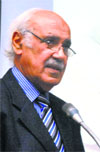Patiala, Punjab: Nearly 8,000 letters and documents written in Persian are lying at Anarkali’s Tomb in Pakistan’s Lahore city and their translation could provide an insight into the undocumented administrative and personal details of Maharaja Ranjit Singh, says art historian Fakir Syed Aijazuddin from Lahore.
“During course of research for my book that traces the history of Maharaja Ranjit Singh’s rule through the careers of three Muslim brothers, I came across voluminous court records of Ranjit Singh lying in Anarkali’s Tomb,” he said during a seminar on his book titled “The Resourceful Fakirs: Three Muslim Brothers at the Sikh Court of Lahore” at Punjabi University here today.
Aijazuddin is a descendent of Maharaja Ranjit Singh’s most trusted courtiers at the Sikh Durbar of Lahore — Fakir Azizuddin, Fakir Imamuddin and Fakir Nuruddin.
“The Punjab Civil Administration in the Punjab State Archives has preserved the documents in the tomb, but they cannot be scanned. If we can find people for the apt translation of the documents, they would be of help to historians and others,” he said.
The art historian said he found references for his book from the letters and 640 pages of Roznamcha (daily record) written by Fakir Azizuddin, Maharaja’s indispensable spokesperson and trusted negotiator in all dealings he had with neighbours surrounding his kingdom, including the British.
“They were written on behalf of Maharaja and provide an insight into the personality of the great Sikh ruler. I am not saying the Sikh ruler has been an underwritten subject, but there are many more things about him that the available documents can provide,” Aijazuddin said.
He said: “‘The Resourceful Fakirs’ traces the history of Maharaja Ranjit Singh’s rule, under which Punjab was unified for the only time in its tumultuous history, and the role played by the three Muslim brothers. The book talks about Maharaja Ranjit Singh’s coterie and the relationship he shared with the three brothers.”
In addition to creating pen portraits of the three brothers, the writer has included portraits, engravings, maps and period photographs.
Source: The Tribune
 Sikh Sangat News Celebrating Sikh culture and sharing Sikh voices
Sikh Sangat News Celebrating Sikh culture and sharing Sikh voices

